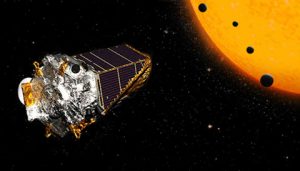Kepler’s K2 mission has confirmed 104 new exoplanets — including a system with four rocky planets.

NASA / JPL
In 2009, NASA launched Kepler with the intention of searching for Earth-sized planets orbiting stars similar to the Sun. In 2014, the aging telescope entered a second life, searching for exoplanets across a broader swath of sky. Of 197 planet candidates, scientists have now confirmed 104 planets that range between 20% and 50% times larger than Earth’s diameter.
Crossfield and colleges confirmed the large number of exoplanets by combining Kepler data with follow-up observations from groundbased telescopes such as the North Gemini telescope and the Keck Observatory. The discoveries were published online in the Astrophysical Journal Supplement Series.
Detecting Exoplanets
Kepler discovers transiting planets — those that pass in front of their star and subtly dim its brightness. Over its four-year survey, Kepler surveyed one patch of the sky in the northern hemisphere. During that time, it found 4,696 candidate exoplanets — 2,329 of these were confirmed as of July 18, 2016.
K2 is an extension of the Kepler missionthat covers more of the sky, albeit with lower pointing accuracy. This has allowed it to observe a larger fraction of cooler, smaller, and often nearby red dwarf stars, which are much more common in the Milky Way than Sun-like stars. To date, the K2 mission has found 458 candidate planets, 127 of which have been confirmed. The general scientific community proposes all K2 targets.
"An analogy would be to say that Kepler performed a demographic study, while the K2 mission focuses on the bright and nearby stars with different types of planets," says Ian Crossfield (University of Arizona) in a press release.
Among the confirmed planets is a four-planet, potentially rocky, system orbiting the M dwarf star K2-72 181 light-years away in Aquarius. These planets have periods ranging from 5.5 to 24 days and despite their smaller-than-Mercury orbits, the possibility that life could exist on a planet around such a star cannot be ruled out, according to Crossfield.
In addition to finding planet candidates, K2 has already revealed oscillations in variable stars and discovered eclipsing binaries and supernovae. Astronomers expect K2 will discover between 500 and 1,000 planets in its planned three- to four-year mission.
 0
0









Comments
You must be logged in to post a comment.